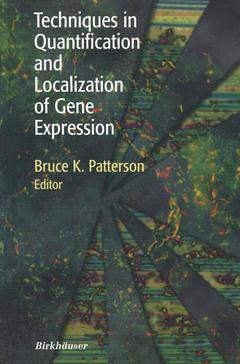Techniques in Quantification and Localization of Gene Expression, 2000
Langue : Anglais
Coordonnateur : Patterson Bruce K.

Can the son or daughter of a baseball pitcher or cricket bowler throw a ball 100 miles an hour? Is the son or daughter of an opera singer also an opera singer? Is a house with functional light switches lit? The line of thinking in these rhetorical questions also applies to human genetics. What do baseball pitchers, opera sing ers, light switches, and the Human Genome Project have in common? These questions address the issue of potential versus realization of function. Although sons and daughters of baseball pitchers and opera singers may have inherited the mechanical attributes to be baseball pitchers and opera singers, they may not, at any point in time, be baseball pitchers or opera singers. A house with functional light switches is not lit unless the light switches are on. Similarly, all of the genes discovered and sequenced as a result of the Human Genome Project are not expressed at the same time. Genome project information will allow us to deter mine the repertoire of genes in an individual, which is analogous to determining where the light switches in a house are located and whether they are functional (a mutation or deletion in the Genome Project Model). The pattern of "on" light switches in a house gives us functional information as to what the family inside is doing (e. g. , eating, reading, sleeping). Similarly, the pattern of gene expression (RNA) gives us information on what our bodies are doing (e. g.
Basic Methods.- 1. Basic Flow Cytometry Instrumentation.- Instrumentation.- Overview.- Delivery of Sample.- Light Source and Signal Detection.- Data Analysis.- Gating.- Color Compensation.- Conclusion.- 2. Fixation for In Situ Molecular Analysis.- Types of Fixatives.- Cells.- Tissue.- 3. A Method for Reduction of Green Wavelength Autofluorescence Emission in Cellular Preparations.- Protocols—Flow Cytometry.- Trypan Blue with Surface Staining.- Surface Stain Plus In Situ Hybridization.- Surface Label Plus In Situ PCR or RT-PCR.- 4. Gene Quantification: Choosing the Target.- Fresh Cells and Tissue.- Quantification of Gene Expression Prior to In Situ Analysis.- 5. Detection and Quantification of Cytokine-Producing Cells by Immunostaining.- Materials.- Methods.- Procedure 1: Cytokine Detection of Individual Cells Smeared on Slides Using Immunostaining.- Quantification of Individual Cytokine-Producing Cells by Automated Computerized Image Analysis (ACIA).- Assessment of Cell Size, Intensity of Signal, and Enumeration of Individual Cytokine-Producing Cells.- Procedure 2: Immunofluorescent Staining of Cytokine-Producing Cells in Suspension.- Procedure 3. Cytokine Detection in Tissue Using Immunohistochemistry.- Troubleshooting.- 6. In Situ Hybridization Using the bDNA Technology.- Materials and Methods.- Reagents.- Preparation of Cytospin Slides.- Pretreatment of Slides Prior to Hybridization.- Hybridization and Signal Development.- Results and Discussion.- Conclusions.- Acknowledgments.- Specific Applications.- 7. Kaposi’s Sarcoma—Associated Human Herpes Virus Eight: Localization of Viral Gene Expression and Viral Latency.- Materials and Methods.- Clinical Samples.- Solution-Based PCR and Serologic Assays.- In Situ Hybridization.- In Situ Polymerase Chain Reaction.- Results.- Discussion.- 8. Pathogenetic Mechanisms of Animal Orbiviruses That Cause Disease at Low Copy Number.- Materials and Methods.- Experimental Design.- Clinical Samples.- Virus Isolation.- Immunochemistry.- Nested Reverse Transcription Polymerase Chain Reaction.- In Situ Hybridization.- Reverse Transcription In Situ Polymerase Chain Reaction.- Results.- Clinicopathologic Features.- Isolation and Typing of Viruses.- Tissue Distribution and Cellular Localization of Viral Proteins and Nucleic Acids.- Discussion.- 9. Localization of Hepatitis C Virus Using Reverse Transcriptase Fluorescence In Situ 5’ Nuclease Assay.- Determining the Localization Method.- Detection of Gene Expression in Specific Cell Types.- 10. Simultaneous Quantification and Localization of HIV gag-pol Expression Using Ultrasensitive Fluorescence In Situ Hybridization.- 11. Quantification and Localization of Gene Expression: Future Directions.
Date de parution : 01-2000
Ouvrage de 150 p.
15.5x23.5 cm
Thème de Techniques in Quantification and Localization of Gene... :
Mots-clés :
DNA; HIV; RNA; biotechnology; cell lines; cytokine; fluorescence; gene expression; genes; genetics; hybridization; molecular biology; protein; tissue; virus
© 2024 LAVOISIER S.A.S.


